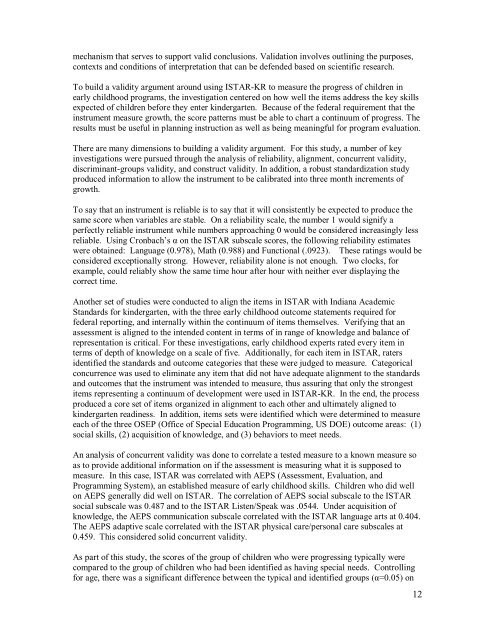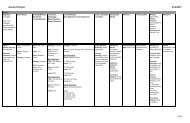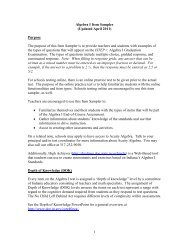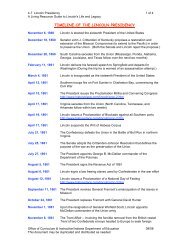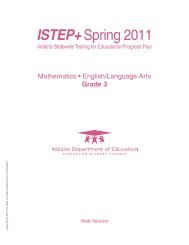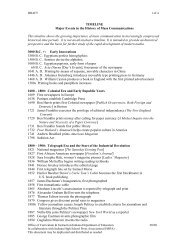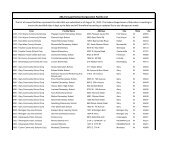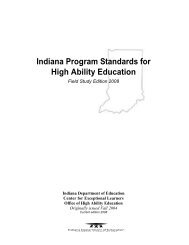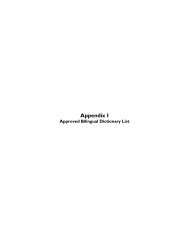Early Childhood ISTAR-KR Assessment Handbook - Indiana ...
Early Childhood ISTAR-KR Assessment Handbook - Indiana ...
Early Childhood ISTAR-KR Assessment Handbook - Indiana ...
Create successful ePaper yourself
Turn your PDF publications into a flip-book with our unique Google optimized e-Paper software.
mechanism that serves to support valid conclusions. Validation involves outlining the purposes,<br />
contexts and conditions of interpretation that can be defended based on scientific research.<br />
To build a validity argument around using <strong>ISTAR</strong>-<strong>KR</strong> to measure the progress of children in<br />
early childhood programs, the investigation centered on how well the items address the key skills<br />
expected of children before they enter kindergarten. Because of the federal requirement that the<br />
instrument measure growth, the score patterns must be able to chart a continuum of progress. The<br />
results must be useful in planning instruction as well as being meaningful for program evaluation.<br />
There are many dimensions to building a validity argument. For this study, a number of key<br />
investigations were pursued through the analysis of reliability, alignment, concurrent validity,<br />
discriminant-groups validity, and construct validity. In addition, a robust standardization study<br />
produced information to allow the instrument to be calibrated into three month increments of<br />
growth.<br />
To say that an instrument is reliable is to say that it will consistently be expected to produce the<br />
same score when variables are stable. On a reliability scale, the number 1 would signify a<br />
perfectly reliable instrument while numbers approaching 0 would be considered increasingly less<br />
reliable. Using Cronbach’s α on the <strong>ISTAR</strong> subscale scores, the following reliability estimates<br />
were obtained: Language (0.978), Math (0.988) and Functional (.0923). These ratings would be<br />
considered exceptionally strong. However, reliability alone is not enough. Two clocks, for<br />
example, could reliably show the same time hour after hour with neither ever displaying the<br />
correct time.<br />
Another set of studies were conducted to align the items in <strong>ISTAR</strong> with <strong>Indiana</strong> Academic<br />
Standards for kindergarten, with the three early childhood outcome statements required for<br />
federal reporting, and internally within the continuum of items themselves. Verifying that an<br />
assessment is aligned to the intended content in terms of in range of knowledge and balance of<br />
representation is critical. For these investigations, early childhood experts rated every item in<br />
terms of depth of knowledge on a scale of five. Additionally, for each item in <strong>ISTAR</strong>, raters<br />
identified the standards and outcome categories that these were judged to measure. Categorical<br />
concurrence was used to eliminate any item that did not have adequate alignment to the standards<br />
and outcomes that the instrument was intended to measure, thus assuring that only the strongest<br />
items representing a continuum of development were used in <strong>ISTAR</strong>-<strong>KR</strong>. In the end, the process<br />
produced a core set of items organized in alignment to each other and ultimately aligned to<br />
kindergarten readiness. In addition, items sets were identified which were determined to measure<br />
each of the three OSEP (Office of Special Education Programming, US DOE) outcome areas: (1)<br />
social skills, (2) acquisition of knowledge, and (3) behaviors to meet needs.<br />
An analysis of concurrent validity was done to correlate a tested measure to a known measure so<br />
as to provide additional information on if the assessment is measuring what it is supposed to<br />
measure. In this case, <strong>ISTAR</strong> was correlated with AEPS (<strong>Assessment</strong>, Evaluation, and<br />
Programming System), an established measure of early childhood skills. Children who did well<br />
on AEPS generally did well on <strong>ISTAR</strong>. The correlation of AEPS social subscale to the <strong>ISTAR</strong><br />
social subscale was 0.487 and to the <strong>ISTAR</strong> Listen/Speak was .0544. Under acquisition of<br />
knowledge, the AEPS communication subscale correlated with the <strong>ISTAR</strong> language arts at 0.404.<br />
The AEPS adaptive scale correlated with the <strong>ISTAR</strong> physical care/personal care subscales at<br />
0.459. This considered solid concurrent validity.<br />
As part of this study, the scores of the group of children who were progressing typically were<br />
compared to the group of children who had been identified as having special needs. Controlling<br />
for age, there was a significant difference between the typical and identified groups (α=0.05) on<br />
12


